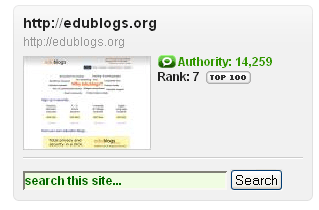… then you should put it in your sidebar at Edublogs.
Blogging tips by Lorelle
Hurrah, received my copy today of Blogging Tips by Lorelle.
And just to prove it’s arrived, here it is with some genuine Aussie bush in the background!

You can grab your own copy here.
A Short History of WordPress MultiUser (WPMU)
This is a short tale about how one developer’s inspiration has led to a revolution in online publishing.
On October 4th 2004 Donncha O Caoimh released WPMU 0.1 aka WordPress MultiUser aka WordPressµ.
Come late ‘04 and early ‘05 there were a lot of us playing around with WPMU and when WordPress 1.5 came about, WPMU was none too far behind.
So… we played around with smarty templates, and generally enjoyed the fun of it all until Donncha started aiming for an “option so that Smarty and WP themes can be mixed on the one host!”
And WPMU as we know it was born.
The forums were relaunched, WPMUDEV.ORG provided (and still provides) the extra goodies, a certain individual known as Matt came aboard, Blogsome (perhaps the first major WPMU host) took off.
Before long there were all sorts of sites sprouting up, from Edublogs (that’s me BTW :) to Pontolistpress, The Jackass Journal, ILDNPlanet.net and others.
And, of course, there was that little known site, WordPress.com.
So what has WPMU done for you? What has it done for the web?
Well, besides being the stand out of multi-user blogging platforms, as far back as 2005, it’s a brilliant example of how open source software can work alongside commercial organisations.
When Automattic kicked off with the .com many a naysayer would have predicted the demise of WordPress, but in fact it’s gone from strength to strength. Aligning an open source platform with a commercial entity has meant a boon for them (vast community input) and an amazing amount of direction and support for the rest of us.
Without Automattic , I have no doubt that WPMU would not be what it is today.
And where are we at today? Well, that’s quite something.
Not only are there over a million blogs at WordPress.com but there are far far more at a whole heap of other blog hosting sites, not to mention Universities like Harvard and newspapers like Le Monde. Heck, I even got a job pitching about how The Age could use WPMU – not that they did, but that’s another story.
WPMU has given people with a server, a half decent grasp of php and a lot of enthusiasm the opportunity to start real communities – communities where every member has their own space and where the beauty of WordPress has been made available to writers, vodcasters and podcasters the world over who don’t want to worry about how to set up an sql database.
WPMU has transformed the blogging world, hang in here for the rest of the trip and you just might see it transform the web itself.
Update: Donncha delves deeper than I managed to, pointing out the role http://blogs.linux.ie/ played in it all:
“Making logs available to the members of the Irish Linux Users Group at linux.ie was my primary motivation in the first place for getting tarted on all this. I based my original code on b2, the predecessor of WordPress, and called it b2++. There are a few posts on my blog if you want to go look…. once b2 became WP I adapted the code to work with the new project, and WPMU is the result!“
WordPress and security
This is absolute troll-esque nonsense. sure, we could all always do security better but to recommend, ahem:
If you do want to install weblog software, I recommend Movable Type. It is possible to set up a very secure install if you don’t need things like comments
Makes you sound a bit silly, in so many different ways.
For a more reasoned response read Matt.
Edublogs – top 10 website?
OK, this is posted with more than just a pinch of salt… and perhaps says more about Technorati than it does about us, but all the same, check this out:

Heh…. and especially when you compare it to the $40m p/year website I’ve just left…

So how have I managed to get a higher Technorati ranking for Edublogs than one of the top websites in Australia? Answers on the back of a blank postcard in the comments please :)
Education.yawn?
Is anyone else profoundly unimpressed by the new Education.com site?
Out of the boardroom and into the classroom… help requested!
Walter Jennings, who I’m helping out with blog stuff, is making the transition from boardroom to classroom next month and is uncharacteristically concerned.
 Walter’s the MD of a big PR firm here in Au so I reckon it rocks that he’s taking time to not just do an invitational lecture but to teach a whole course.
Walter’s the MD of a big PR firm here in Au so I reckon it rocks that he’s taking time to not just do an invitational lecture but to teach a whole course.
Having said that, with no background as a teacher he’s wondering how to keep a whole bunch of undergrads engaged… and doing some learning too.
So have you got any tips for a experienced business pro who’s also a classroom n00b? Go help a man out!
Selfish altruism
Stephen responds to my contention that we’re all selfish brutes:
“People like to create content, and they like to help each other – they aren’t inherently selfish; there’s lots of evidence to show they want to share, even if there’s no benefit to themselves. What they don’t feel the need to do, though, is to provide institutional-type content to institutional-type repositories.” – Stephen Downes
And I agree, to an extent, in that we are, by nature, altruistic individuals (it’s hard wired, we’d be stuffed without it) and are certainly less motivated to help out institutions (although, ironically, that’s what most of us do, all day, every weekday) BUT it’s important to recognise that at the same time we are inherently selfish… and that that’s no bad thing.
Because, if you want *anything* social on the web to succeed you have to pay *much* attention to that.
This is the point where I reveal where I lifted much of my thinking (and those gmail / social bookmarking examples) from, Derek Powazek’s Design for Community and 2006 post Design for Selfishness where he argues that:
“While it’s true that the net can inspire altruistic sharing of people’s time and talent, you still have to offer those people something for their troubles. If you have to pick between designing for altruism and designing for selfishness, pick selfishness every time.
People are selfish, and that’s okay. People are selfish with their time. They should be – there’s never enough of it. And they’re selfish with their attention – after all, if you pay attention to everything, you’d never get out of bed. Finally, and most importantly, they’re selfish with their talent. Writing that post, uploading that photo, participating in your virtual community … all of that is work for me. So what are you going to do to make it worth it?” – Derek Powazek
It’s a post anyone trying to start anything on the web should read, consider, and apply to what they’re doing.
LOR and other ‘crowd’ applications particularily.
And when you’re done, read about how crowds (if you do get them together) are not necessarily always wise. Brilliant stuff that many of us trying to create the web ignore on a daily basis (myself included!)
We could do with a little less utopianism when it comes to social software and the web, education in particular.
Good LORd
“A bunch of folks (myself included) took up the task of building software to let people easily publish, describe, share, find (and hopefully use) digital assets or learning objects (assets with a bunch of metadata tacked on the side). I think it’s fair to say that the experiments failed pretty dramatically. The only content that was added to CAREO was done under the auspices of Large Projects and/or Institutions. Individuals, by and large, didn’t spend much time with it, or its ilk. Why is that?” – D’Arcy Norman
Well, how much time do you have… actually, D’Arcy comes up with three pretty good reasons around sharing, API and social aspects, but if I could pick one reason why these toppled (I got to watch some Uni ones topple up close, ’twas fun) it would be this: WHY WOULD I (OR ANYONE ELSE FOR THAT MATTER) BOTHER.
Honestly, forget the good of humanity, helping others and all that jazz, we’re essentially pretty selfish beings, and it’s important to respect that because this stuff isn’t really going to work as long as we ignore that or look for fanciful tech-based solutions.
Sure, we may have great tools and be a lot more advanced in our understanding of how we can socially create sites, but I don’t reckon we’re any closer – or really ever will be – to a crowd / tech driven solution – it’s just too hard.
And let’s remember that we tag spam in gmail not because we want to help the community, but because we don’t want spam.
We use social bookmarking services not because we want top be social, but because we want to access our links from anywhere, tag them ‘n stuff.
And we add content to sites like fOUnd it because… oh hang on, we don’t, because IT DOES NOTHING FOR US.
I reckon there are really only two solutions:
Institutionally you can look into providing employees (be they academics, teachers or so on) with tools which they really want to use to help them teach, research and so on (easy, huh!) which you can then aggregate in various ways. Alas, simply sucking up Word & PowerPoint docs might be the way to go. Incidentally, this one is tricky to a. get right & b. do without turning into a police state.
Globally I’m afraid that there might be a harsh truth here… you may, actually, shudder, need to employ a genuine human bean of sorts! Yes, that’s right, a real person, equipped of course with mucho understanding of how one finds appropriate stuff, but very real nonetheless who can tag, file, link to, archive and generally organise stuff. Heck, you might even need a few of them, put them in a building together and get them to…
… hang on, isn’t that called a, library :)
incorporated subversion surprise entry at no. 35
 Mucho shock at the incsub ranch this morning as we discovered that incorporated subversion had entered the top 100 Australian blogs at number 35.
Mucho shock at the incsub ranch this morning as we discovered that incorporated subversion had entered the top 100 Australian blogs at number 35.
Just behind Nik, but crucially ahead of BB.
Now to consolidate the position and move up the chart! With riviting readership-driven posts just like this! And lots of exclamation marks!
But no emoticons you will note… it’s – so – hard.
Incidentally, I finally ditched the incsub.org / newincorg3.wpmudev.host divide the other week so now all root links, bar a couple of essays, go to newincorg3.wpmudev.host… I can heartily recommend the Permacop WordPress plugin for anyone thinking of something similar.